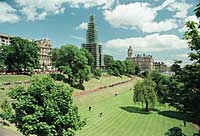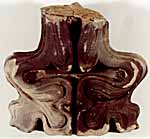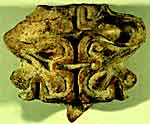 The
photograph on the left was taken in the summer of 1998, looking
across Princess Street Gardens, with the Scott Monument in the distance,
completely covered in scaffolding during the restoration process. The
photograph on the left was taken in the summer of 1998, looking
across Princess Street Gardens, with the Scott Monument in the distance,
completely covered in scaffolding during the restoration process.
The proposed cleaning of the Scott Monument provoked much debate,
and many opinions were expressed both for and against the cleaning
of it. Eventually a scientific /geological investigation was called
for and some of the evidence is shown here.
There is a legacy of damage done to historic buildings through
ill-informed cleaning. Stone-cleaning is a complex business and
these images show to a wider audience the reasoning behind the decision
not to clean.
The Scott Monument is built of a stone which contains a residue
of shale-oil that attracts and binds with soot and grime from the
atmosphere, particularly from the old coal-fired steam trains which
used to pass close by. The soot and dirt on the stone was particularly
well attached and ingrained into the surface, and to remove the
dirt would mean removing the surface, allowing the stone to weather
and deteriorate.
 This
stone foliage detail on the left, is Binny stone, taken from the
Scott Monument and used as part of the cleaning trials. This example
was subjected to ‘air-abrasion’ with ‘alumina’
abrasive powder, whereby the sand-like material is blasted under
pressure at the blackened surface of stone. It is trained onto the
surface through nozzles, great care must be used not to etch the
surface. This
stone foliage detail on the left, is Binny stone, taken from the
Scott Monument and used as part of the cleaning trials. This example
was subjected to ‘air-abrasion’ with ‘alumina’
abrasive powder, whereby the sand-like material is blasted under
pressure at the blackened surface of stone. It is trained onto the
surface through nozzles, great care must be used not to etch the
surface.
Often this method will remove the blackened surface of the stone,
but allow water and weathering to penetrate the stone. This will
accelerate the deterioration of the stone and ultimately the monument.
In 1932 D. Tait adddressed the properties of the bituminous presence
thus:
“The Binny sandstone is wellknown to be a very
durable building material. It might be contended that the small
amount of oil in it contributes to this durability by excluding
water; but the oil probably has another effect. The Scott Monument
and [National] Art Galleries, which are largely built of Binny Sandstone,
are disfigured by black patches on the surface of the stone. These
patches are generally said to be caused by the smoke of the city,
and by the smoke of the locomotives of the railway close at hand.
But a close inspection of the distribution and shape of the sooty
patches and bands, coupled with the knowledge that the rock does
contain oil, suggests the conclusion that the darker markings are
oily patches to which cling a specially thick coating of soot.”
 This
stone detail was cleaned chemically - with a solution of Ammonium
Hydrogen Fluoride, which acts like a bleach on dirt attached to
the stone. The solution is applied in a gel form and left for up
to 24 hours before being neutralised and washed off. However as
can be seen from the image the results can be quite patchy and ultimately
aesthetically displeasing. This
stone detail was cleaned chemically - with a solution of Ammonium
Hydrogen Fluoride, which acts like a bleach on dirt attached to
the stone. The solution is applied in a gel form and left for up
to 24 hours before being neutralised and washed off. However as
can be seen from the image the results can be quite patchy and ultimately
aesthetically displeasing.
The chemical has turned iron compounds in the stone to a rusty
red colour, and ‘cleaned’ the surface quite unevenly.
|



